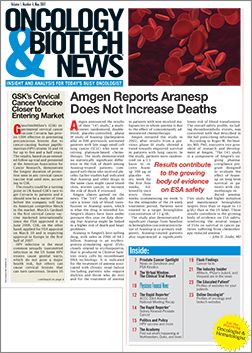Amgen Reports Aranesp Does Not Increase Deaths
The results of Amgen's "145 study" of Aranesp in patient's with late-stage small-cell lung cancer (SCLC) are released.
Click here to view as PDF.
Results Contribute to the Growing Body of Evidence on ESA Safety
Amgen announced the results of their “145 study,” a multicenter, randomized, doubleblind, placebo-controlled, phase III study of Aranesp (darbepoetin alfa) in 600 previously untreated patients with late-stage small-cell lung cancer (SCLC) who were receiving
platinum-based chemotherapy. The study demonstrated no statistically significant difference in the risk of death among Aranesp-treated patients compared with those who received placebo. Earlier studies had indicated that Aranesp and other drugs in the same class might cause blood clots, worsen cancer, or increase the risk of death if overused.
Amgen shares gained on the news. The “145” study did indicate a lower risk of blood transfusions in Aranesp users, which is what the drug is intended for. Amgen’s shares have been under pressure this year on data showing that Aranesp might be linked to a higher risk of death and heart problems.
Aranesp is Amgen’s best-selling drug, with sales in 2006 of $4.1 billion. Aranesp is an erythropoiesis-stimulating agent (ESA), closely related to erythropoietin, that is produced in Chinese hamster ovary cells by recombinant DNA technology. It is indicated for the treatment of anemia associated with chronic renal failure (including patients who require dialysis and those who do not) and for the treatment of anemia in patients with non-myeloid malignancies in whom anemia is due to the effect of concomitantly administered
chemotherapy.
Amgen initiated the study in 2002, after results from a previous phase III study showed a trend towards improved survival in patients with lung cancer. In the study, patients were randomized on a 1:1 basis to receive Aranesp 300 μg or placebo every week for the first four weeks, followed by once every three weeks (commencing on week 5) for the remainder of the 24-week treatment period. Patients were treated to a target hemoglobin concentration of 13 g/dL.
The study also demonstrated a significant change from baseline in hemoglobin concentration in favor of Aranesp (a co-primary endpoint). Aranesp-treated patients also experienced a significantly lower risk of blood transfusions. The overall safety profile, including thromboembolic events, was consistent with that described in the full prescribing information.
According to Roger M. Perlmutter, MD, PhD, executive vice president of research and development at Amgen, “The 145 study is a component of Amgen’s ongoing pharmacovigilance program designed to evaluate the effect of Aranesp on long-term survival in patients with chemotherapy-induced anemia. This study had higher initiation and maintenance hemoglobin targets (less than or equal to 13 g/dL) than in the US label. These results contribute to the growing body of evidence on ESA safety, reinforcing the neutral impact of ESAs on survival in cancer patients suffering from chemotherapy-induced anemia.”
